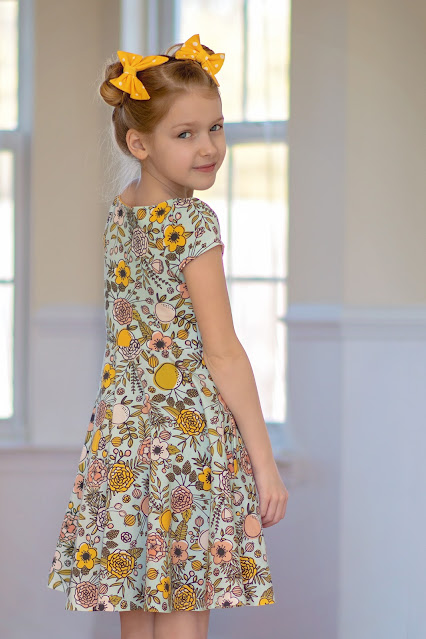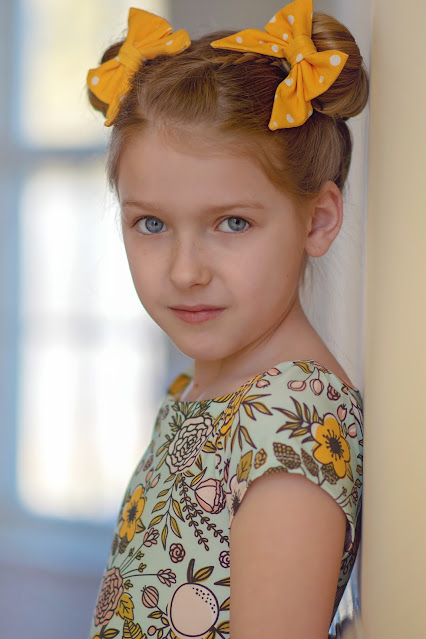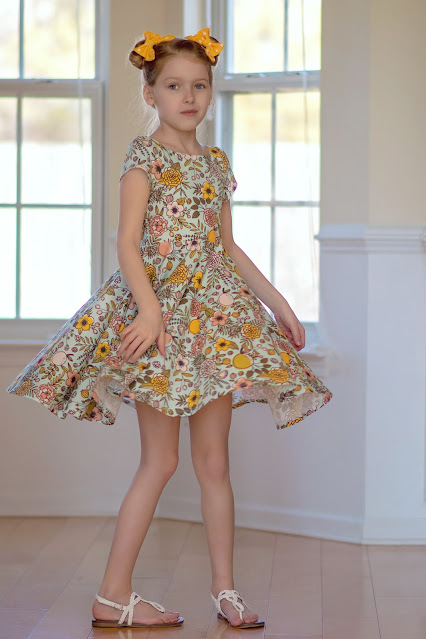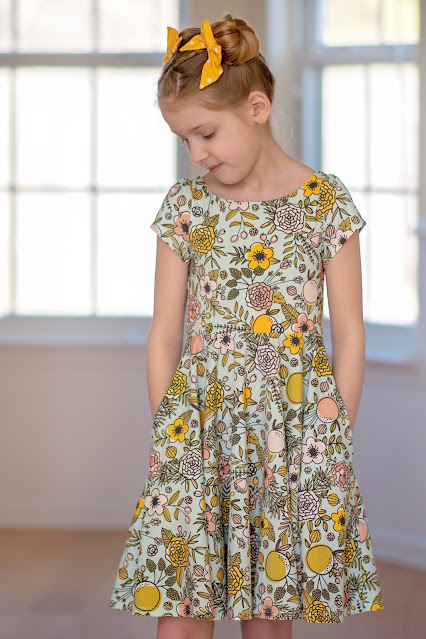Tips for Working with Knit Fabrics
Posted by Natasha Chrismas on
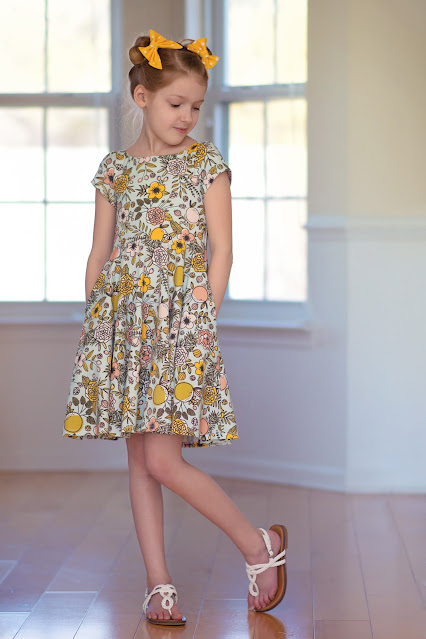 |
| Fabric: Bold Floral in Light Aquamarine & Dotty in Daffodil Yellow | Peachy Meadows Collection by Mariah Danielle Design |
- Not all knit fabrics are equal! In a world where most items are ordered online, you really can't feel the fabric to see if it's what you are looking for. Here are some basic details to look for:
- Fabric content: A basic cotton spandex knit is 95% cotton and 5% spandex (or Lycra). This is a great stable knit, especially for beginners. Of course, the selection of knits is huge and can also include interlock, poly blends, ity, hacci, french terry, waffle and so many more! (The fabric shown in this post is Jersey Knit -- 95% cotton/5% spandex)
- Stretch: Stretch can be 2-way (side to side) or 4-way (side to side and up and down). The percentage of stretch can vary too -- from very little to 75% stretch or more. A basic cotton spandex will generally be around 50% stretch, 4-way. The Wattle pattern comes with instructions and a printable stretch calculator to help you determine if your knit "passes the stretch test". Each pattern will tell you what the required stretch is in the 'Materials Needed' section.
- Recovery: This refers to how well the fabric "bounces back" after being stretch out. Cotton spandex usually has 100% recovery where an interlock has much less recovery. This is important because after wearing your creation, you don't want it all stretched out!
- Prewash your fabric!!! Knit fabrics shrink (more than wovens) so prewashing is super important. I wash it in warm water and dry on normal heat -- exactly how I wash my normal laundry.
- Pay attention to grain and stretch direction when cutting. Grain of knit is vertical (parallel to the selvages) just like with woven. The stretch is usually the greatest from side to side. If you gently pull on the sides of knit and look closely, you'll see tiny vertical lines separating the more you stretch. You will want these lines to be vertical on your garment. Of course, on a circle skirt like on Wattle, the sides of skirt will have these lines sideways. That is okay!!
- Use a ballpoint needle! Not all needles are the same. Ballpoint needles have a rounded tip vs a sharp piercing tip of other needles. The rounded tip will gently separate your knit fibers as it sews which prevents holes that other needles can create.
- Use a stretch stitch on your sewing machine (or use a 4-thread serger stitch). Using a normal straight stitch will cause popped stitches and quite possibly, a wardrobe malfunction in public. There are several types of stretch stitches:
- the "Lightning Bolt" is my favorite -- it literally looks like a lightning bolt (not every machine has this though)
- the "Zigzag" -- this is a basic stitch that every machine should have. I choose the longest length and then choose a narrower width.
- the "Triple Stretch" -- this stitch most closely resembles a straight stitch, but still stretches. This is the most secure stitch, but also the hardest to unpick if you need to fix a mistake.
- The 4 thread serger stitch secures your seam and provides a nice finish to your edges. (Knit doesn't fray however so a finished edge is purely cosmetic).
- Do not pull on your fabric as you sew to prevent unwanted stretching out. Because knits are stretchy, it's important to guide your fabric through your machine, but avoid pulling on it (unless it is a neckband or something that is intended to be stretched as it's attached). If you finish sewing a seam and it appears wavy, it likely got stretched out.
- Steam from your iron will usually help it pop back into shape.
- If you are on a sewing machine, lessen your foot pressure or use a walking foot for even feeding.
- If you are on a serger, increase your differential feed which eliminates the waviness.
- Clips are better than pins. Pins put unnecessary holes in your knit. If you don't have any clips, I like to use bobby pins. I can get a whole pack at the dollar store super cheap, they hold really well, and I can slip them on my fabric without lifting it.
- Hemming knit fabric tips: Knit hems only need to be folded once which helps reduce bulk. A slightly deeper hem will prevent your hem from flipping upward when worn. The hem on the Wattle is 1/2" and is perfect. I used a coverstitch here, but you can also hem using a twin needle, zig zag stitch or a longer straight stitch (on a circle skirt because no stretch is needed). To keep your hem even, you can use a long basting stitch as a fold guide and simply remove after hemming. Hem tape is also very popular and helps prevent the hem from shifting and causing a "roping" effect.
Knit patterns have quickly become some of my most used patterns. If you're new to knits and the first time is intimidating or your project didn't quite turn out as planned, do not give up! My first time was quite frankly a hot mess (but I made a lot of errors that could have been avoided if I had a list like the one above!). The Wattle is a great introductory pattern to knit -- the bodice is lined so there is no neckband to worry about and the skirt is a circle which is super easy to attach! I added the free pockets and accessorized with the Bluebell Bow in Baby Size.

